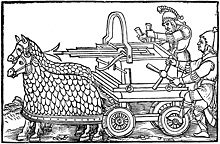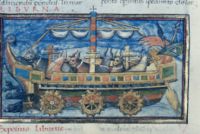De rebus bellicis
- De rebus bellicis
-

gravure d'une
baliste dans une édition de 1552
De rebus bellicis est un ouvrage anonyme du IVe ou Ve siècle en bas latin répertoriant bon nombre de machine de guerre utilisées par l'armée romaine.
Histoire
De rebus bellicis a vraisemblablement été écrit après la mort de Constantin, puisque les manuscrits dont nous disposons parlent de lui, mais il a été écrit avant la chute de l'empire d'occident. Ce texte nous est vraisemblablement parvenu par un seul ouvrage du Xe siècle et perdu au XVIe siècle, le Spirensis. Trois des textes du XVe et XVIe siècle connus dérivent de façon probable d'un manuscrit conservé à la Bibliothèque nationale de France, sous la référence Ms lat 9661.
Éditions
- Anonymi Auctoris De Rebus Bellicis. recensvit Robert I. Ireland (Bibliotheca scriptorvm Graecorvm et Romanorvm Tevbneriana), Lipsiae, 1984.
- "Anónimo Sobre Asuntos Militares", Edited, trans. and comm. by Álvaro Sánchez–Ostiz (EUNSA), Pamplona, 2004.
Wikimedia Foundation.
2010.
Contenu soumis à la licence CC-BY-SA. Source : Article De rebus bellicis de Wikipédia en français (auteurs)
Regardez d'autres dictionnaires:
De rebus bellicis — Ox powered Roman paddle wheel boat from a 15th century copy of De Rebus Bellicis … Wikipedia
De Rebus Bellicis — Römisches Schaufelradschiff nach De Rebus Bellicis. Miniatur aus dem 15. Jahrhundert De Rebus Bellicis ist eine römische Kriegsschrift aus dem 4. Jahrhundert n. Chr., in der sich der unbekannte Verfasser mit verschiedenen Reformvorschlägen… … Deutsch Wikipedia
De Rebus Bellicis — is a 4th or 5th century anonymous work about war machines used by the Roman army of the time. Date of the writing De Rebus Bellicis was surely written after the death of Constantine I (337; explicitly states that Constantine was dead when the… … Wikipedia
De Rebus Bellicis — Late fourth century military treatise by an anonymous Latin writer. The treatise is addressed to the reigning emperors (q.v.), perhaps Valentinian I and Valens (qq.v.). The author considers himself a reformer, but the reforms he recommends… … Historical dictionary of Byzantium
In rebus bellicis maxime dominatur fortuna. — См. В схватке счастье великое дело … Большой толково-фразеологический словарь Михельсона (оригинальная орфография)
Plumbata (dart) — Plumbatae or martiobarbuli were lead weighted darts carried by infantrymen in Antiquity and the Middle Ages. History The first examples seem to have been carried by the Ancient Greeks from about 500 B.C. onwards, but the best known user were the… … Wikipedia
Plumbata — This article is part of the series on: Military of ancient Rome (portal) 753 BC – AD 476 Structural history Roman army (unit types and ranks … Wikipedia
Water wheel — This article is about the machine for converting energy of flowing or falling water. For paddle wheels used to propel watercraft, see paddle wheel ship. For wheels used solely to lift water, see Noria. For factories or industries driven by water… … Wikipedia
Constantine the Great — This article is about Constantine as an Emperor. For Constantine as a Saint, see Constantine I and Christianity. Constantine I redirects here. For other uses, see Constantine I (disambiguation). Constantine I 57th Emperor of the Roman Empire … Wikipedia
Rotareme — Römisches Schaufelradschiff (Miniatur aus dem 15. Jh.) Rotareme (lateinisch rotaremis ‚Drehruder‘, von rota ‚drehen‘ und remus ‚Ruder, Riemen‘) ist die moderne Bezeichnung für ein antikes Schaufelradschiff mit Schaufelrädern an den Seiten. In… … Deutsch Wikipedia

 gravure d'une baliste dans une édition de 1552
gravure d'une baliste dans une édition de 1552

